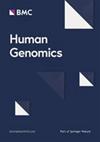新型 DNAH11 变异与无精子症导致男性不育的关系
IF 3.8
3区 医学
Q2 GENETICS & HEREDITY
引用次数: 0
摘要
DNAH11 的双等位基因变异已被确定为原发性纤毛运动障碍的致病因素,会导致呼吸道纤毛异常。然而,这些变异体对人类精子鞭毛的具体影响及其与男性不育的关系在很大程度上仍然未知。中国两家生殖中心合作开展了一项研究,研究对象是975名无血缘关系的不育男性。研究采用了全外显子组测序法进行变异筛选,并通过桑格测序法确认了所发现的变异。使用扫描电子显微镜和透射电子显微镜对精子进行了形态学和超微结构分析。利用 Western 印迹分析和免疫荧光分析评估蛋白质水平和定位。进行了卵胞浆内单精子显微注射(ICSI),以评估其对 DNAH11 变体个体获得良好妊娠结果的有效性。在这项研究中,我们在四名无精子症患者中发现了 DNAH11 基因的七个新变体。这些变异导致了精子鞭毛中DNAH11蛋白的缺失和超微结构缺陷,尤其影响了精子的外动力臂(ODA)和邻近结构。外动力臂蛋白DNAI2和轴丝相关蛋白的水平被下调,而内动力臂(IDA)蛋白DNAH1和DNAH6的水平被下调。四名DNAH11变异者中有两人通过卵胞浆内单精子显微注射(ICSI)成功怀孕。研究结果证实,男性不育与DNAH11的双等位基因有害变异有关,这些变异会导致精子鞭毛的异常组装,造成无精子症。重要的是,卵胞浆内单精子显微注射(ICSI)是克服DNAH11基因变异导致的生殖难题的有效干预措施。本文章由计算机程序翻译,如有差异,请以英文原文为准。
Association of novel DNAH11 variants with asthenoteratozoospermia lead to male infertility
Bi-allelic variants in DNAH11 have been identified as causative factors in Primary Ciliary Dyskinesia, leading to abnormal respiratory cilia. Nonetheless, the specific impact of these variants on human sperm flagellar and their involvement in male infertility remain largely unknown. A collaborative effort involving two Chinese reproductive centers conducted a study with 975 unrelated infertile men. Whole-exome sequencing was employed for variant screening, and Sanger sequencing confirmed the identified variants. Morphological and ultrastructural analyses of sperm were conducted using Scanning Electron Microscopy and Transmission Electron Microscopy. Western Blot Analysis and Immunofluorescence Analysis were utilized to assess protein levels and localization. ICSI was performed to evaluate its efficacy in achieving favorable pregnancy outcomes for individuals with DNAH11 variants. In this study, we identified seven novel variants in the DNAH11 gene in four asthenoteratozoospermia subjects. These variants led the absence of DNAH11 proteins and ultrastructure defects in sperm flagella, particularly affecting the outer dynein arms (ODAs) and adjacent structures. The levels of ODA protein DNAI2 and axoneme related proteins were down regulated, instead of inner dynein arms (IDA) proteins DNAH1 and DNAH6. Two out of four individuals with DNAH11 variants achieved clinical pregnancies through ICSI. The findings confirm the association between male infertility and bi-allelic deleterious variants in DNAH11, resulting in the aberrant assembly of sperm flagella and contributing to asthenoteratozoospermia. Importantly, ICSI emerges as an effective intervention for overcoming reproductive challenges caused by DNAH11 gene variants.
求助全文
通过发布文献求助,成功后即可免费获取论文全文。
去求助
来源期刊

Human Genomics
GENETICS & HEREDITY-
CiteScore
6.00
自引率
2.20%
发文量
55
审稿时长
11 weeks
期刊介绍:
Human Genomics is a peer-reviewed, open access, online journal that focuses on the application of genomic analysis in all aspects of human health and disease, as well as genomic analysis of drug efficacy and safety, and comparative genomics.
Topics covered by the journal include, but are not limited to: pharmacogenomics, genome-wide association studies, genome-wide sequencing, exome sequencing, next-generation deep-sequencing, functional genomics, epigenomics, translational genomics, expression profiling, proteomics, bioinformatics, animal models, statistical genetics, genetic epidemiology, human population genetics and comparative genomics.
 求助内容:
求助内容: 应助结果提醒方式:
应助结果提醒方式:


